Physical Inactivity and Obesity among Aboriginals: An Evidence-Based Nursing Report
VerifiedAdded on 2023/04/21
|11
|2652
|113
AI Summary
This evidence-based nursing report highlights the issue of physical inactivity leading to obesity among Aboriginals. It explores the role of education from nurses in increasing health awareness and decreasing obesity.
Contribute Materials
Your contribution can guide someone’s learning journey. Share your
documents today.
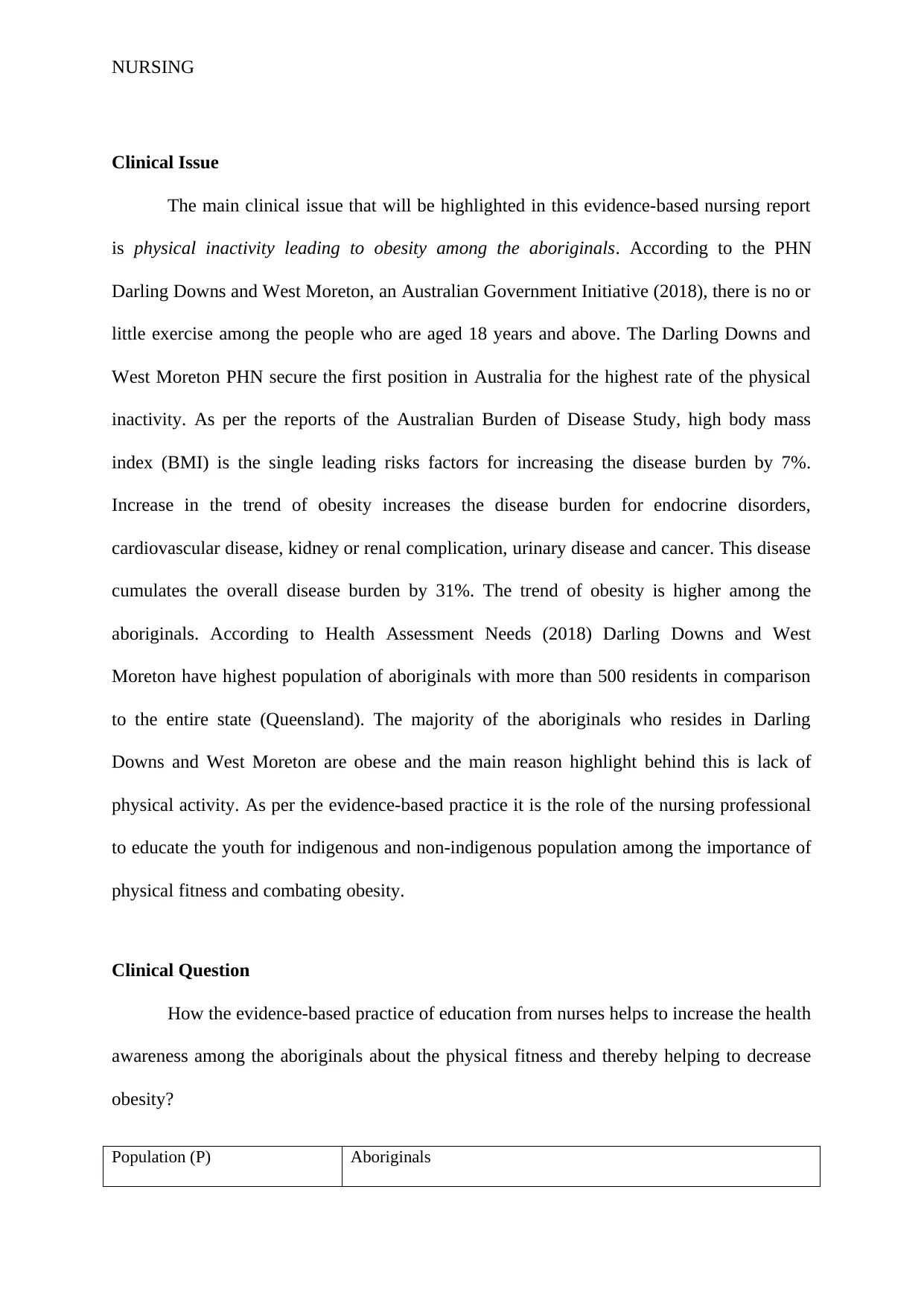
NURSING
Clinical Issue
The main clinical issue that will be highlighted in this evidence-based nursing report
is physical inactivity leading to obesity among the aboriginals. According to the PHN
Darling Downs and West Moreton, an Australian Government Initiative (2018), there is no or
little exercise among the people who are aged 18 years and above. The Darling Downs and
West Moreton PHN secure the first position in Australia for the highest rate of the physical
inactivity. As per the reports of the Australian Burden of Disease Study, high body mass
index (BMI) is the single leading risks factors for increasing the disease burden by 7%.
Increase in the trend of obesity increases the disease burden for endocrine disorders,
cardiovascular disease, kidney or renal complication, urinary disease and cancer. This disease
cumulates the overall disease burden by 31%. The trend of obesity is higher among the
aboriginals. According to Health Assessment Needs (2018) Darling Downs and West
Moreton have highest population of aboriginals with more than 500 residents in comparison
to the entire state (Queensland). The majority of the aboriginals who resides in Darling
Downs and West Moreton are obese and the main reason highlight behind this is lack of
physical activity. As per the evidence-based practice it is the role of the nursing professional
to educate the youth for indigenous and non-indigenous population among the importance of
physical fitness and combating obesity.
Clinical Question
How the evidence-based practice of education from nurses helps to increase the health
awareness among the aboriginals about the physical fitness and thereby helping to decrease
obesity?
Population (P) Aboriginals
Clinical Issue
The main clinical issue that will be highlighted in this evidence-based nursing report
is physical inactivity leading to obesity among the aboriginals. According to the PHN
Darling Downs and West Moreton, an Australian Government Initiative (2018), there is no or
little exercise among the people who are aged 18 years and above. The Darling Downs and
West Moreton PHN secure the first position in Australia for the highest rate of the physical
inactivity. As per the reports of the Australian Burden of Disease Study, high body mass
index (BMI) is the single leading risks factors for increasing the disease burden by 7%.
Increase in the trend of obesity increases the disease burden for endocrine disorders,
cardiovascular disease, kidney or renal complication, urinary disease and cancer. This disease
cumulates the overall disease burden by 31%. The trend of obesity is higher among the
aboriginals. According to Health Assessment Needs (2018) Darling Downs and West
Moreton have highest population of aboriginals with more than 500 residents in comparison
to the entire state (Queensland). The majority of the aboriginals who resides in Darling
Downs and West Moreton are obese and the main reason highlight behind this is lack of
physical activity. As per the evidence-based practice it is the role of the nursing professional
to educate the youth for indigenous and non-indigenous population among the importance of
physical fitness and combating obesity.
Clinical Question
How the evidence-based practice of education from nurses helps to increase the health
awareness among the aboriginals about the physical fitness and thereby helping to decrease
obesity?
Population (P) Aboriginals
Secure Best Marks with AI Grader
Need help grading? Try our AI Grader for instant feedback on your assignments.
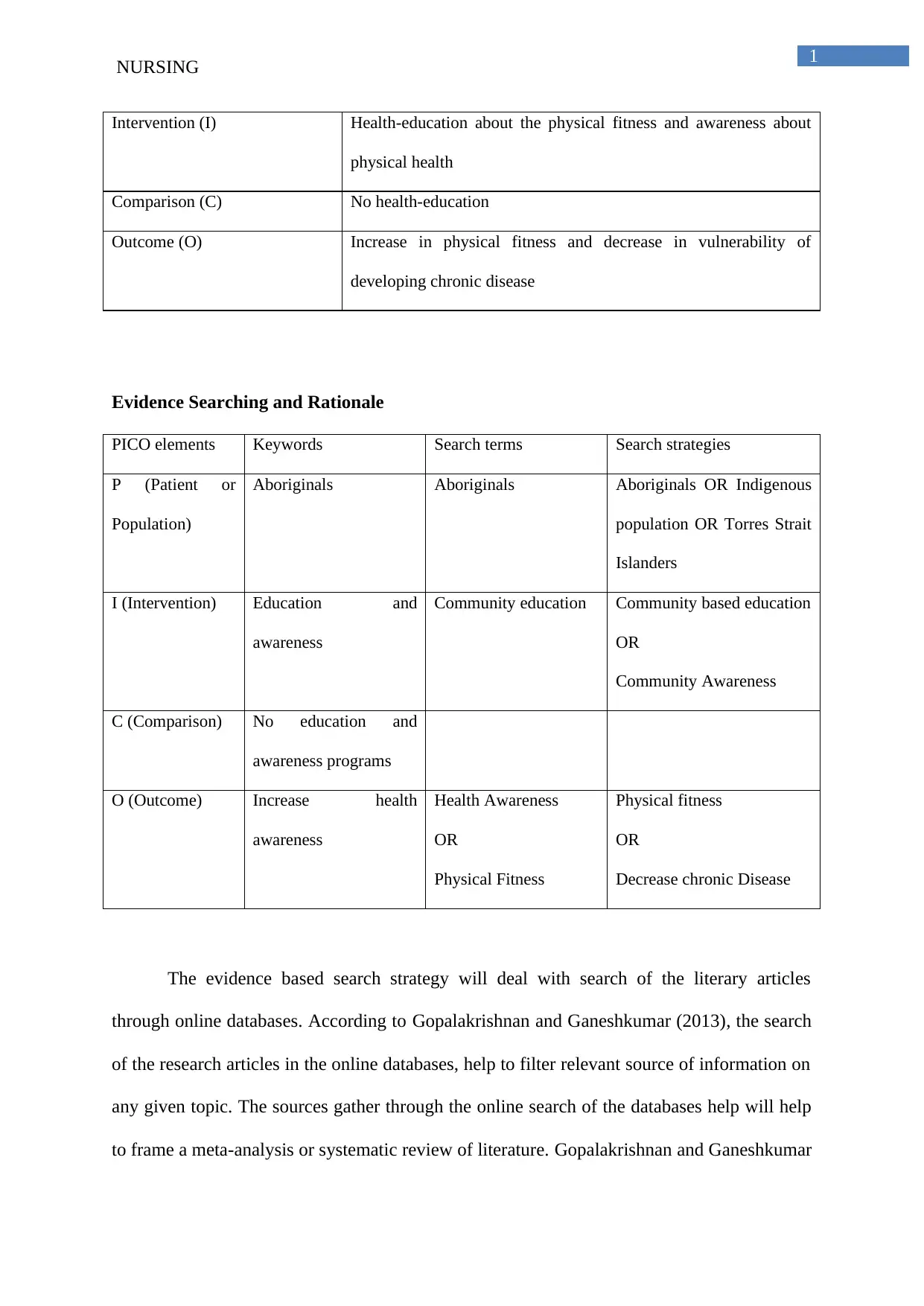
1
NURSING
Intervention (I) Health-education about the physical fitness and awareness about
physical health
Comparison (C) No health-education
Outcome (O) Increase in physical fitness and decrease in vulnerability of
developing chronic disease
Evidence Searching and Rationale
PICO elements Keywords Search terms Search strategies
P (Patient or
Population)
Aboriginals Aboriginals Aboriginals OR Indigenous
population OR Torres Strait
Islanders
I (Intervention) Education and
awareness
Community education Community based education
OR
Community Awareness
C (Comparison) No education and
awareness programs
O (Outcome) Increase health
awareness
Health Awareness
OR
Physical Fitness
Physical fitness
OR
Decrease chronic Disease
The evidence based search strategy will deal with search of the literary articles
through online databases. According to Gopalakrishnan and Ganeshkumar (2013), the search
of the research articles in the online databases, help to filter relevant source of information on
any given topic. The sources gather through the online search of the databases help will help
to frame a meta-analysis or systematic review of literature. Gopalakrishnan and Ganeshkumar
NURSING
Intervention (I) Health-education about the physical fitness and awareness about
physical health
Comparison (C) No health-education
Outcome (O) Increase in physical fitness and decrease in vulnerability of
developing chronic disease
Evidence Searching and Rationale
PICO elements Keywords Search terms Search strategies
P (Patient or
Population)
Aboriginals Aboriginals Aboriginals OR Indigenous
population OR Torres Strait
Islanders
I (Intervention) Education and
awareness
Community education Community based education
OR
Community Awareness
C (Comparison) No education and
awareness programs
O (Outcome) Increase health
awareness
Health Awareness
OR
Physical Fitness
Physical fitness
OR
Decrease chronic Disease
The evidence based search strategy will deal with search of the literary articles
through online databases. According to Gopalakrishnan and Ganeshkumar (2013), the search
of the research articles in the online databases, help to filter relevant source of information on
any given topic. The sources gather through the online search of the databases help will help
to frame a meta-analysis or systematic review of literature. Gopalakrishnan and Ganeshkumar
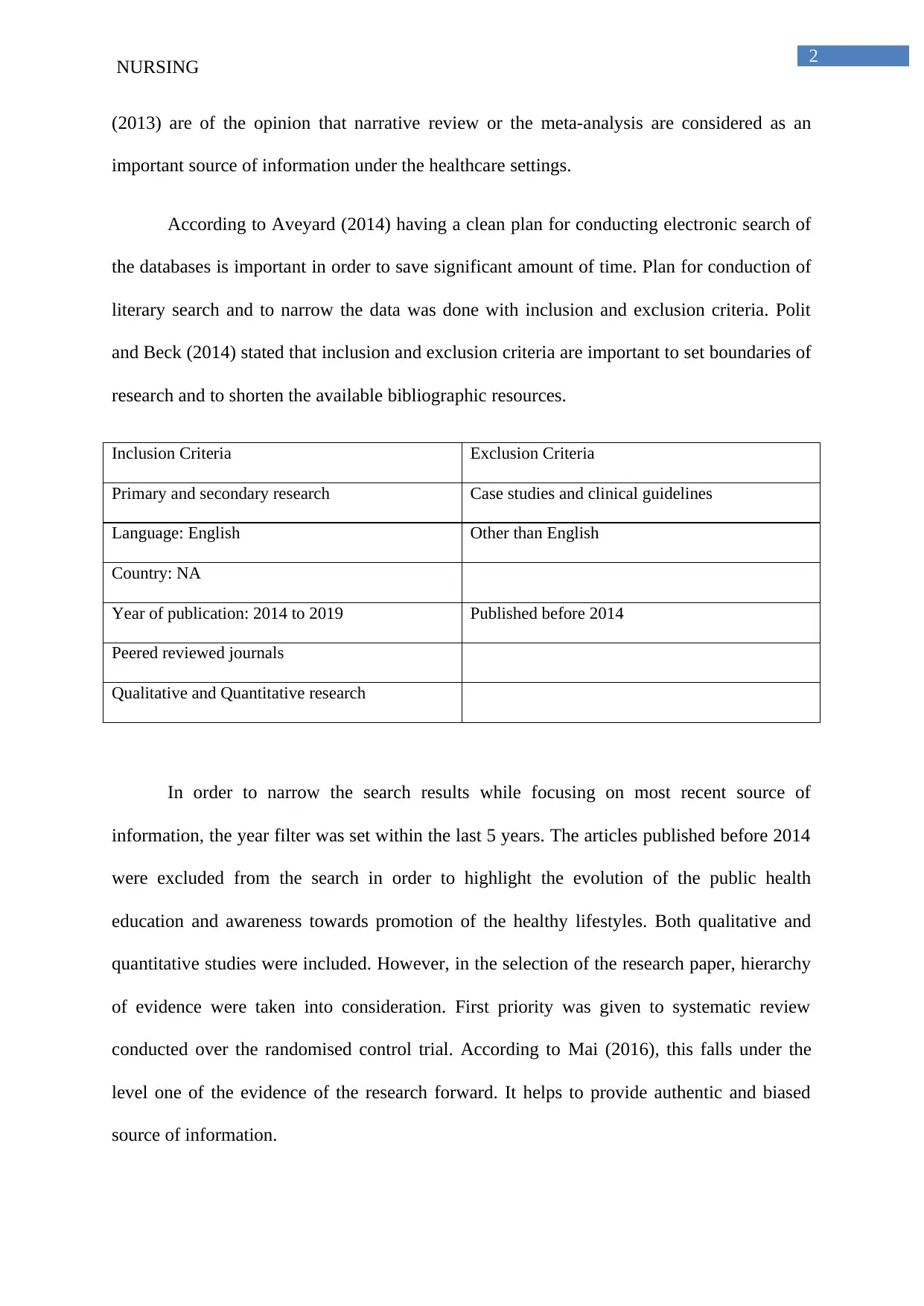
2
NURSING
(2013) are of the opinion that narrative review or the meta-analysis are considered as an
important source of information under the healthcare settings.
According to Aveyard (2014) having a clean plan for conducting electronic search of
the databases is important in order to save significant amount of time. Plan for conduction of
literary search and to narrow the data was done with inclusion and exclusion criteria. Polit
and Beck (2014) stated that inclusion and exclusion criteria are important to set boundaries of
research and to shorten the available bibliographic resources.
Inclusion Criteria Exclusion Criteria
Primary and secondary research Case studies and clinical guidelines
Language: English Other than English
Country: NA
Year of publication: 2014 to 2019 Published before 2014
Peered reviewed journals
Qualitative and Quantitative research
In order to narrow the search results while focusing on most recent source of
information, the year filter was set within the last 5 years. The articles published before 2014
were excluded from the search in order to highlight the evolution of the public health
education and awareness towards promotion of the healthy lifestyles. Both qualitative and
quantitative studies were included. However, in the selection of the research paper, hierarchy
of evidence were taken into consideration. First priority was given to systematic review
conducted over the randomised control trial. According to Mai (2016), this falls under the
level one of the evidence of the research forward. It helps to provide authentic and biased
source of information.
NURSING
(2013) are of the opinion that narrative review or the meta-analysis are considered as an
important source of information under the healthcare settings.
According to Aveyard (2014) having a clean plan for conducting electronic search of
the databases is important in order to save significant amount of time. Plan for conduction of
literary search and to narrow the data was done with inclusion and exclusion criteria. Polit
and Beck (2014) stated that inclusion and exclusion criteria are important to set boundaries of
research and to shorten the available bibliographic resources.
Inclusion Criteria Exclusion Criteria
Primary and secondary research Case studies and clinical guidelines
Language: English Other than English
Country: NA
Year of publication: 2014 to 2019 Published before 2014
Peered reviewed journals
Qualitative and Quantitative research
In order to narrow the search results while focusing on most recent source of
information, the year filter was set within the last 5 years. The articles published before 2014
were excluded from the search in order to highlight the evolution of the public health
education and awareness towards promotion of the healthy lifestyles. Both qualitative and
quantitative studies were included. However, in the selection of the research paper, hierarchy
of evidence were taken into consideration. First priority was given to systematic review
conducted over the randomised control trial. According to Mai (2016), this falls under the
level one of the evidence of the research forward. It helps to provide authentic and biased
source of information.
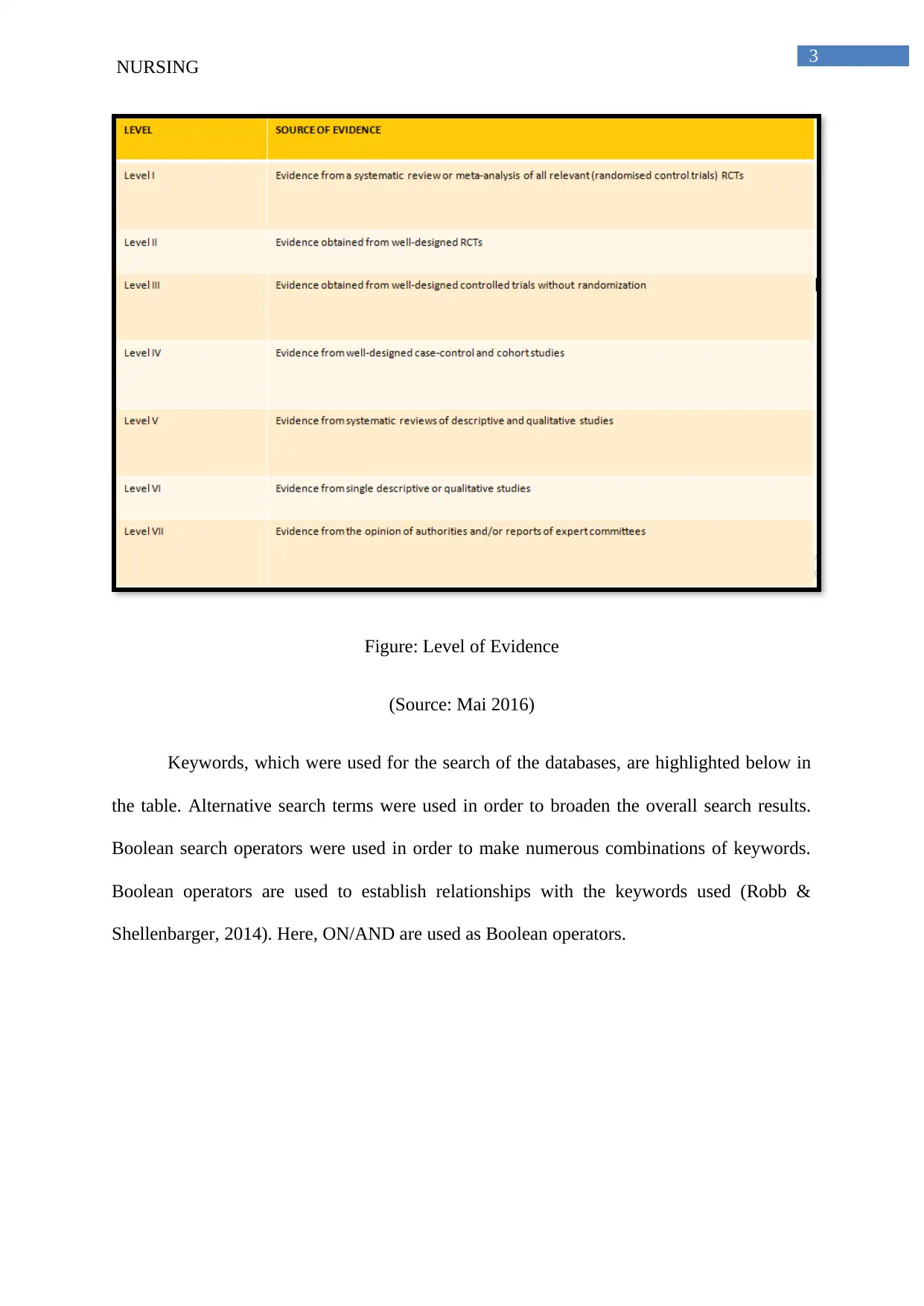
3
NURSING
Figure: Level of Evidence
(Source: Mai 2016)
Keywords, which were used for the search of the databases, are highlighted below in
the table. Alternative search terms were used in order to broaden the overall search results.
Boolean search operators were used in order to make numerous combinations of keywords.
Boolean operators are used to establish relationships with the keywords used (Robb &
Shellenbarger, 2014). Here, ON/AND are used as Boolean operators.
NURSING
Figure: Level of Evidence
(Source: Mai 2016)
Keywords, which were used for the search of the databases, are highlighted below in
the table. Alternative search terms were used in order to broaden the overall search results.
Boolean search operators were used in order to make numerous combinations of keywords.
Boolean operators are used to establish relationships with the keywords used (Robb &
Shellenbarger, 2014). Here, ON/AND are used as Boolean operators.
Secure Best Marks with AI Grader
Need help grading? Try our AI Grader for instant feedback on your assignments.
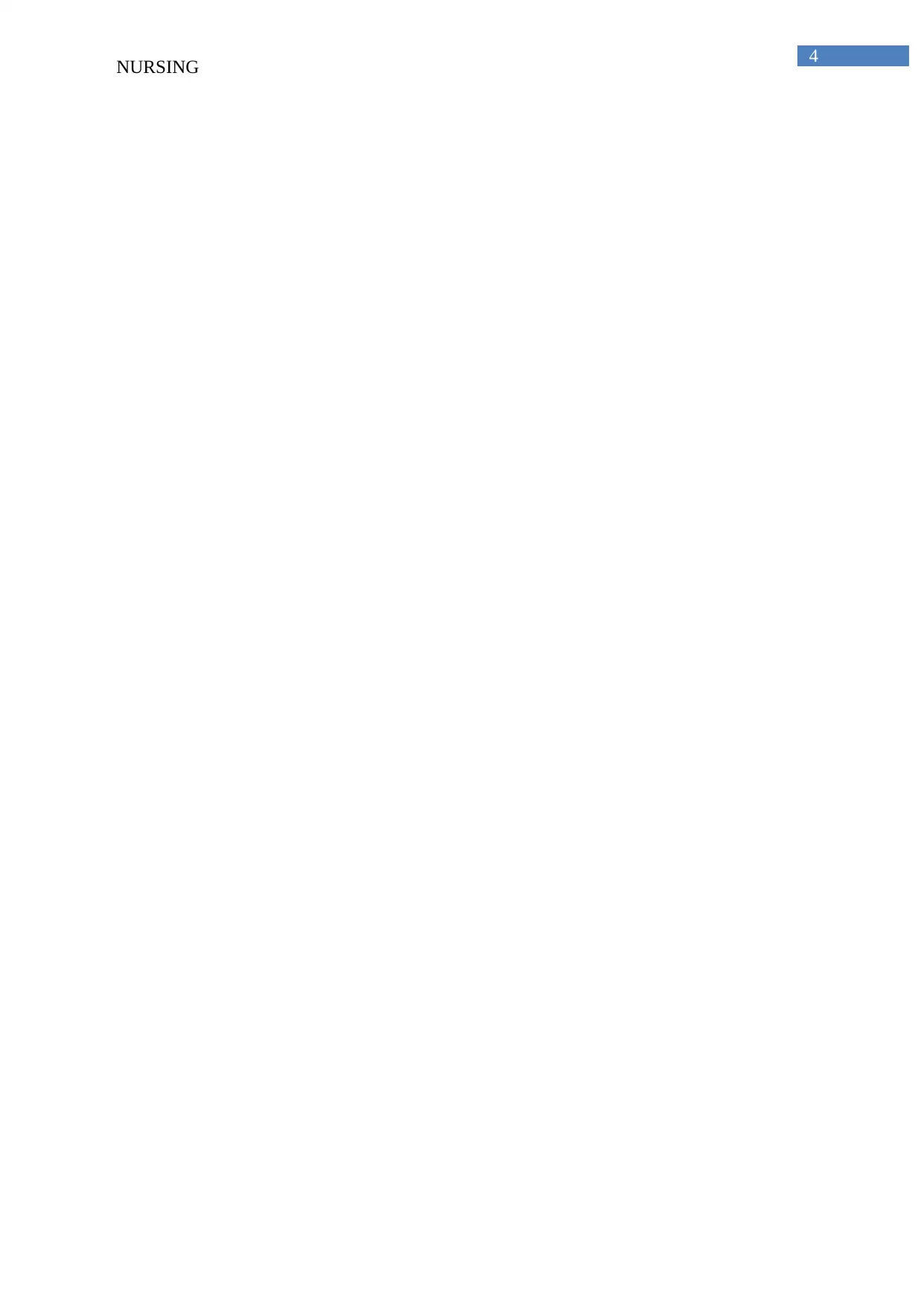
4
NURSING
Keyword:1AboriginalsORTorresStraitIslandersOREthnicMinorityANDKeyword:2EducationORCommunityEducationORAwarenessANDKeyword:3HealthyLifestyleORPhysicalActivityORExercise
NURSING
Keyword:1AboriginalsORTorresStraitIslandersOREthnicMinorityANDKeyword:2EducationORCommunityEducationORAwarenessANDKeyword:3HealthyLifestyleORPhysicalActivityORExercise

5
NURSING
PRISMA Chart for the Search Results
Analysis of the Evidence
Key findings and critical analysis
The research conducted by Passmore et al. (2017), aimed towards identifying
effective healthy lifestyle program in order to address the risk factors behind the development
of chronic diseases among the Aboriginal people like physical inactivity of consumption of
unhealthy food. Passmore et al. (2017) mainly implemented Knockout Health Challenger, a
community based healthy lifestyle program and targeted it towards the aboriginal
Medline (Ovid)
(n=38)
Cochrane library
(n=27)
Web of Science
(n=25)
Scopus
(n=34)
Identification
Records selected through database
searching (n = 124)
Screening
Records after the removal of duplicates (n= 50)
Records excluded based on title
screening (n= 44) Records excluded
based on abstract screening (n=15 )
Total records screened (n =
74)
Eligibility
Full text articles excluded
(n=13)
Full-text articles assessed for eligibility
(n=15)
Included
Studies included
(n= 2)
NURSING
PRISMA Chart for the Search Results
Analysis of the Evidence
Key findings and critical analysis
The research conducted by Passmore et al. (2017), aimed towards identifying
effective healthy lifestyle program in order to address the risk factors behind the development
of chronic diseases among the Aboriginal people like physical inactivity of consumption of
unhealthy food. Passmore et al. (2017) mainly implemented Knockout Health Challenger, a
community based healthy lifestyle program and targeted it towards the aboriginal
Medline (Ovid)
(n=38)
Cochrane library
(n=27)
Web of Science
(n=25)
Scopus
(n=34)
Identification
Records selected through database
searching (n = 124)
Screening
Records after the removal of duplicates (n= 50)
Records excluded based on title
screening (n= 44) Records excluded
based on abstract screening (n=15 )
Total records screened (n =
74)
Eligibility
Full text articles excluded
(n=13)
Full-text articles assessed for eligibility
(n=15)
Included
Studies included
(n= 2)
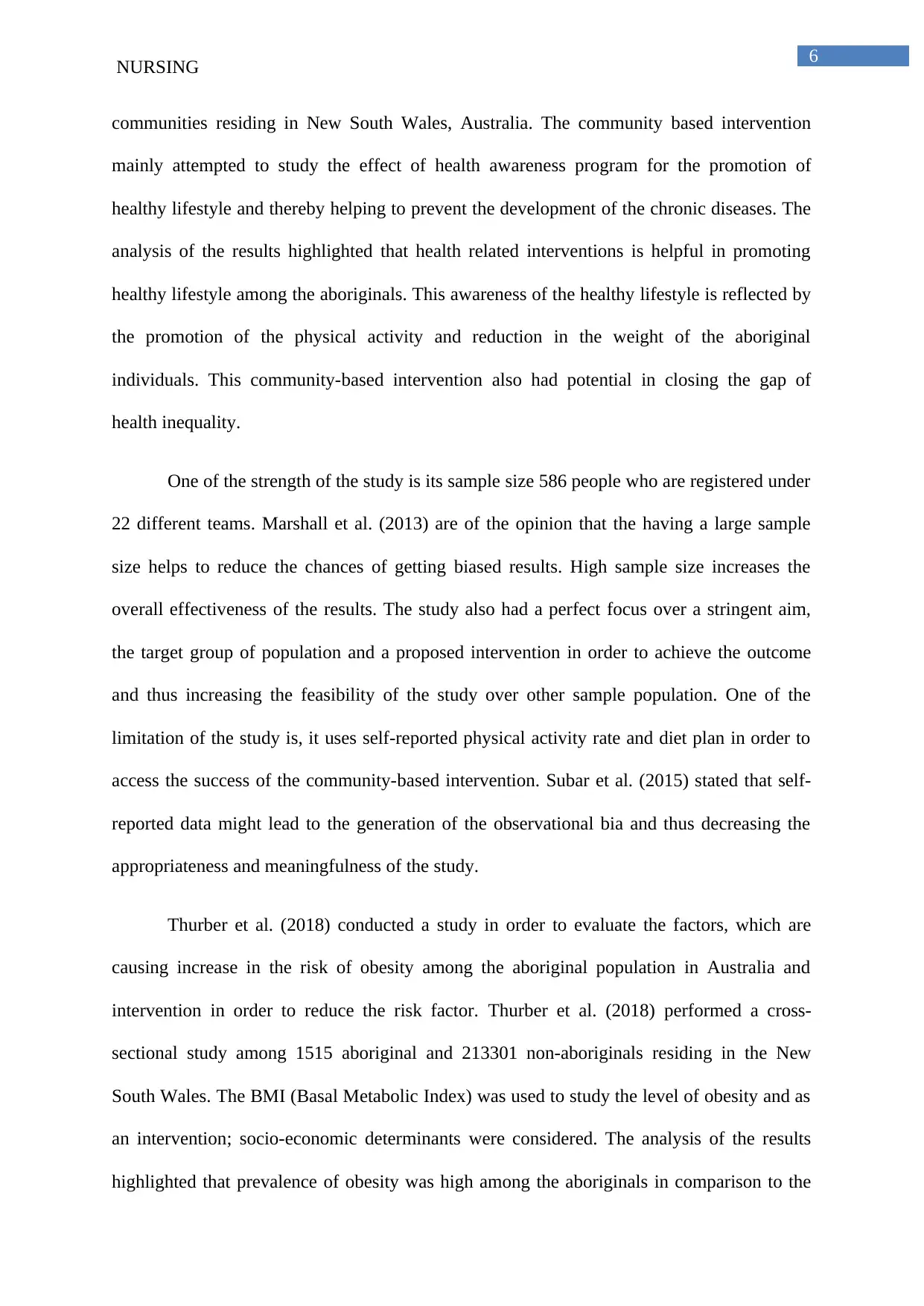
6
NURSING
communities residing in New South Wales, Australia. The community based intervention
mainly attempted to study the effect of health awareness program for the promotion of
healthy lifestyle and thereby helping to prevent the development of the chronic diseases. The
analysis of the results highlighted that health related interventions is helpful in promoting
healthy lifestyle among the aboriginals. This awareness of the healthy lifestyle is reflected by
the promotion of the physical activity and reduction in the weight of the aboriginal
individuals. This community-based intervention also had potential in closing the gap of
health inequality.
One of the strength of the study is its sample size 586 people who are registered under
22 different teams. Marshall et al. (2013) are of the opinion that the having a large sample
size helps to reduce the chances of getting biased results. High sample size increases the
overall effectiveness of the results. The study also had a perfect focus over a stringent aim,
the target group of population and a proposed intervention in order to achieve the outcome
and thus increasing the feasibility of the study over other sample population. One of the
limitation of the study is, it uses self-reported physical activity rate and diet plan in order to
access the success of the community-based intervention. Subar et al. (2015) stated that self-
reported data might lead to the generation of the observational bia and thus decreasing the
appropriateness and meaningfulness of the study.
Thurber et al. (2018) conducted a study in order to evaluate the factors, which are
causing increase in the risk of obesity among the aboriginal population in Australia and
intervention in order to reduce the risk factor. Thurber et al. (2018) performed a cross-
sectional study among 1515 aboriginal and 213301 non-aboriginals residing in the New
South Wales. The BMI (Basal Metabolic Index) was used to study the level of obesity and as
an intervention; socio-economic determinants were considered. The analysis of the results
highlighted that prevalence of obesity was high among the aboriginals in comparison to the
NURSING
communities residing in New South Wales, Australia. The community based intervention
mainly attempted to study the effect of health awareness program for the promotion of
healthy lifestyle and thereby helping to prevent the development of the chronic diseases. The
analysis of the results highlighted that health related interventions is helpful in promoting
healthy lifestyle among the aboriginals. This awareness of the healthy lifestyle is reflected by
the promotion of the physical activity and reduction in the weight of the aboriginal
individuals. This community-based intervention also had potential in closing the gap of
health inequality.
One of the strength of the study is its sample size 586 people who are registered under
22 different teams. Marshall et al. (2013) are of the opinion that the having a large sample
size helps to reduce the chances of getting biased results. High sample size increases the
overall effectiveness of the results. The study also had a perfect focus over a stringent aim,
the target group of population and a proposed intervention in order to achieve the outcome
and thus increasing the feasibility of the study over other sample population. One of the
limitation of the study is, it uses self-reported physical activity rate and diet plan in order to
access the success of the community-based intervention. Subar et al. (2015) stated that self-
reported data might lead to the generation of the observational bia and thus decreasing the
appropriateness and meaningfulness of the study.
Thurber et al. (2018) conducted a study in order to evaluate the factors, which are
causing increase in the risk of obesity among the aboriginal population in Australia and
intervention in order to reduce the risk factor. Thurber et al. (2018) performed a cross-
sectional study among 1515 aboriginal and 213301 non-aboriginals residing in the New
South Wales. The BMI (Basal Metabolic Index) was used to study the level of obesity and as
an intervention; socio-economic determinants were considered. The analysis of the results
highlighted that prevalence of obesity was high among the aboriginals in comparison to the
Paraphrase This Document
Need a fresh take? Get an instant paraphrase of this document with our AI Paraphraser

7
NURSING
non-aboriginals and the main-risk factor behind obesity is physical inactivity. The increase in
the level of physical activity can be promoted via increase in the improvement in the socio-
economic condition. Thurber et al. (2018) are of the opinion that this can be achieved by
increase in education about healthy lifestyles and education about the disease awareness. One
of the limitations of the study is its uneven sample size between the comparative groups
which might lead to the generation of biased results (Marshall et al., 2013). Moreover,
dependence on the self-reported data, mainly the self-reported BMI is the main limitation
study as it might lead to the over and the under-estimation of the BMI and thereby hampering
the appropriateness of the study. Consideration of the wide range of socio-economic data can
be regarded as the strength of the study and thereby helping to improve the effectiveness of
the study (Subar et al., 2015). However, use of the BMI in order to record the obesity help to
increase the feasibility of the study. The overall interpretation of the data and its association
with the socio-economic factors help to increase the meaningfulness of the study in the
evidence based approach.
Conclusion across the evidence
From the above two papers, the evidences highlighted that improvement of the socio-
economic factors in the domain of proper education and awareness is helpful promoting
healthy lifestyle among the aboriginals and this in turn will help to promote physical activity.
Ethical consideration
The papers, which were selected for the critical analysis, stringently abided the main
ethical considerations of the research. The authors of both the research followed the
guidelines as proposed by the Human Research Ethics Committee of the Aboriginal Health.
This can be considered as strength of the study.
NURSING
non-aboriginals and the main-risk factor behind obesity is physical inactivity. The increase in
the level of physical activity can be promoted via increase in the improvement in the socio-
economic condition. Thurber et al. (2018) are of the opinion that this can be achieved by
increase in education about healthy lifestyles and education about the disease awareness. One
of the limitations of the study is its uneven sample size between the comparative groups
which might lead to the generation of biased results (Marshall et al., 2013). Moreover,
dependence on the self-reported data, mainly the self-reported BMI is the main limitation
study as it might lead to the over and the under-estimation of the BMI and thereby hampering
the appropriateness of the study. Consideration of the wide range of socio-economic data can
be regarded as the strength of the study and thereby helping to improve the effectiveness of
the study (Subar et al., 2015). However, use of the BMI in order to record the obesity help to
increase the feasibility of the study. The overall interpretation of the data and its association
with the socio-economic factors help to increase the meaningfulness of the study in the
evidence based approach.
Conclusion across the evidence
From the above two papers, the evidences highlighted that improvement of the socio-
economic factors in the domain of proper education and awareness is helpful promoting
healthy lifestyle among the aboriginals and this in turn will help to promote physical activity.
Ethical consideration
The papers, which were selected for the critical analysis, stringently abided the main
ethical considerations of the research. The authors of both the research followed the
guidelines as proposed by the Human Research Ethics Committee of the Aboriginal Health.
This can be considered as strength of the study.

8
NURSING
Applying Evidence to Practice
The key recommendation in order to increase the overall physical activity and
physical fitness among the aboriginals will include increase in the provision for the
community health interventions and awareness with a detailed focus on the health-related
reduction and vulnerability towards the chronic or non-communicable diseases (Passmore et
al., 2017). The community health education will mainly be undertaken by the community
health nurses. In health interventions and awareness program, the family members or the
direct carers will also be involved in order to increase its overall health outcome (Barr‐
Anderson et al., 2013). The main clinical expertise that will be important in such community
based intervention will include a detailed knowledge about basal metabolic rate and variance
of weight on a basis of height, gender, bone-density and age and amount of calorific required
in the body. The main barriers include absenteeism during the follow-up period. This barrier
can be overcome by the implementation of the financial incentives (Krause, Collen &
Nicholas, 2013). The main ethical considerations that must be taken into consideration in
such community based initiative include culturally sensitivity and respect towards the
autonomy of the service users. The outcomes will evaluated by the decrease in the weight or
the body mass of the participants after one month participation in the community education
program (Carroll-Scott et al., 2013).
NURSING
Applying Evidence to Practice
The key recommendation in order to increase the overall physical activity and
physical fitness among the aboriginals will include increase in the provision for the
community health interventions and awareness with a detailed focus on the health-related
reduction and vulnerability towards the chronic or non-communicable diseases (Passmore et
al., 2017). The community health education will mainly be undertaken by the community
health nurses. In health interventions and awareness program, the family members or the
direct carers will also be involved in order to increase its overall health outcome (Barr‐
Anderson et al., 2013). The main clinical expertise that will be important in such community
based intervention will include a detailed knowledge about basal metabolic rate and variance
of weight on a basis of height, gender, bone-density and age and amount of calorific required
in the body. The main barriers include absenteeism during the follow-up period. This barrier
can be overcome by the implementation of the financial incentives (Krause, Collen &
Nicholas, 2013). The main ethical considerations that must be taken into consideration in
such community based initiative include culturally sensitivity and respect towards the
autonomy of the service users. The outcomes will evaluated by the decrease in the weight or
the body mass of the participants after one month participation in the community education
program (Carroll-Scott et al., 2013).
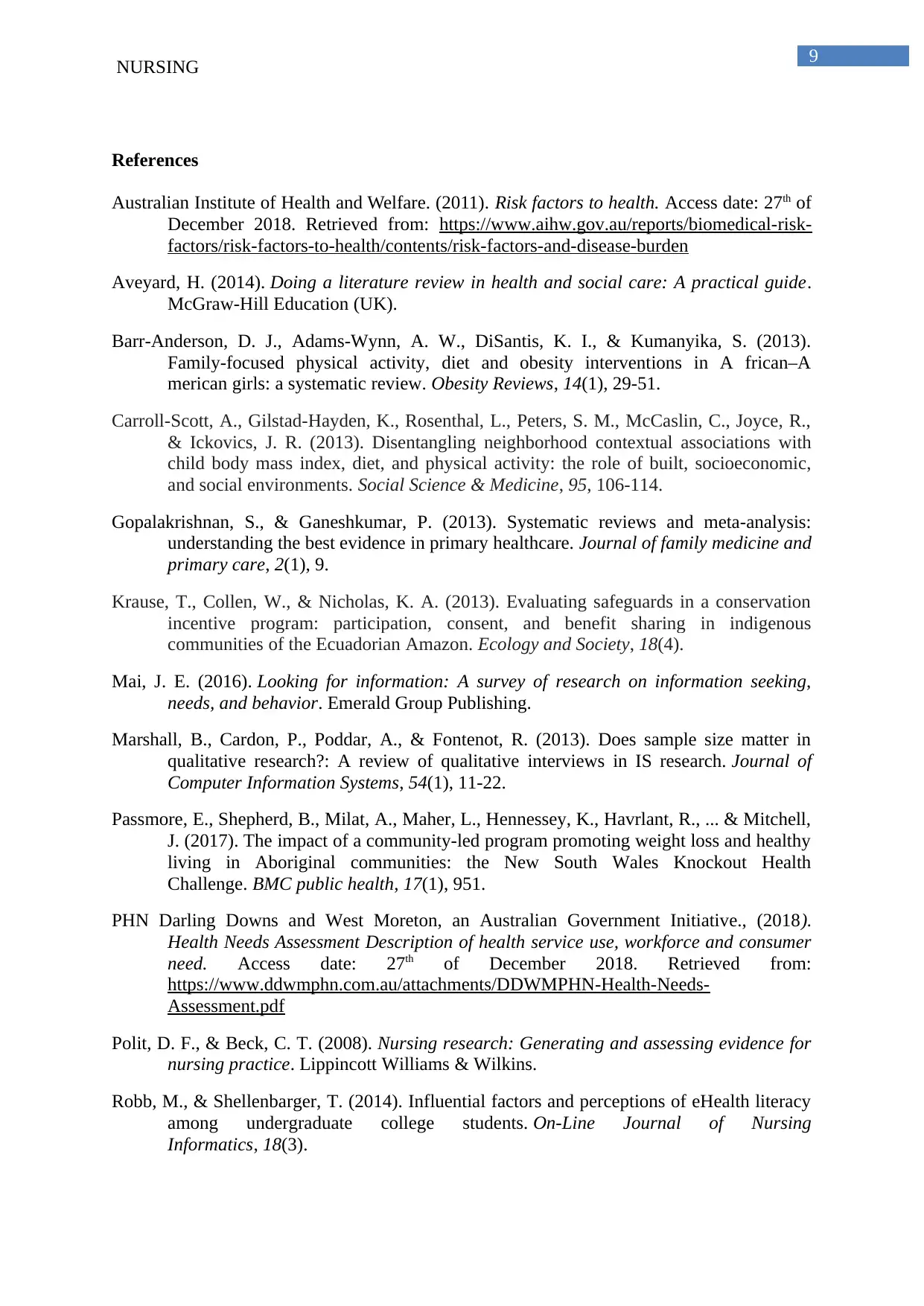
9
NURSING
References
Australian Institute of Health and Welfare. (2011). Risk factors to health. Access date: 27th of
December 2018. Retrieved from: https://www.aihw.gov.au/reports/biomedical-risk-
factors/risk-factors-to-health/contents/risk-factors-and-disease-burden
Aveyard, H. (2014). Doing a literature review in health and social care: A practical guide.
McGraw-Hill Education (UK).
Barr‐Anderson, D. J., Adams‐Wynn, A. W., DiSantis, K. I., & Kumanyika, S. (2013).
Family‐focused physical activity, diet and obesity interventions in A frican–A
merican girls: a systematic review. Obesity Reviews, 14(1), 29-51.
Carroll-Scott, A., Gilstad-Hayden, K., Rosenthal, L., Peters, S. M., McCaslin, C., Joyce, R.,
& Ickovics, J. R. (2013). Disentangling neighborhood contextual associations with
child body mass index, diet, and physical activity: the role of built, socioeconomic,
and social environments. Social Science & Medicine, 95, 106-114.
Gopalakrishnan, S., & Ganeshkumar, P. (2013). Systematic reviews and meta-analysis:
understanding the best evidence in primary healthcare. Journal of family medicine and
primary care, 2(1), 9.
Krause, T., Collen, W., & Nicholas, K. A. (2013). Evaluating safeguards in a conservation
incentive program: participation, consent, and benefit sharing in indigenous
communities of the Ecuadorian Amazon. Ecology and Society, 18(4).
Mai, J. E. (2016). Looking for information: A survey of research on information seeking,
needs, and behavior. Emerald Group Publishing.
Marshall, B., Cardon, P., Poddar, A., & Fontenot, R. (2013). Does sample size matter in
qualitative research?: A review of qualitative interviews in IS research. Journal of
Computer Information Systems, 54(1), 11-22.
Passmore, E., Shepherd, B., Milat, A., Maher, L., Hennessey, K., Havrlant, R., ... & Mitchell,
J. (2017). The impact of a community-led program promoting weight loss and healthy
living in Aboriginal communities: the New South Wales Knockout Health
Challenge. BMC public health, 17(1), 951.
PHN Darling Downs and West Moreton, an Australian Government Initiative., (2018).
Health Needs Assessment Description of health service use, workforce and consumer
need. Access date: 27th of December 2018. Retrieved from:
https://www.ddwmphn.com.au/attachments/DDWMPHN-Health-Needs-
Assessment.pdf
Polit, D. F., & Beck, C. T. (2008). Nursing research: Generating and assessing evidence for
nursing practice. Lippincott Williams & Wilkins.
Robb, M., & Shellenbarger, T. (2014). Influential factors and perceptions of eHealth literacy
among undergraduate college students. On-Line Journal of Nursing
Informatics, 18(3).
NURSING
References
Australian Institute of Health and Welfare. (2011). Risk factors to health. Access date: 27th of
December 2018. Retrieved from: https://www.aihw.gov.au/reports/biomedical-risk-
factors/risk-factors-to-health/contents/risk-factors-and-disease-burden
Aveyard, H. (2014). Doing a literature review in health and social care: A practical guide.
McGraw-Hill Education (UK).
Barr‐Anderson, D. J., Adams‐Wynn, A. W., DiSantis, K. I., & Kumanyika, S. (2013).
Family‐focused physical activity, diet and obesity interventions in A frican–A
merican girls: a systematic review. Obesity Reviews, 14(1), 29-51.
Carroll-Scott, A., Gilstad-Hayden, K., Rosenthal, L., Peters, S. M., McCaslin, C., Joyce, R.,
& Ickovics, J. R. (2013). Disentangling neighborhood contextual associations with
child body mass index, diet, and physical activity: the role of built, socioeconomic,
and social environments. Social Science & Medicine, 95, 106-114.
Gopalakrishnan, S., & Ganeshkumar, P. (2013). Systematic reviews and meta-analysis:
understanding the best evidence in primary healthcare. Journal of family medicine and
primary care, 2(1), 9.
Krause, T., Collen, W., & Nicholas, K. A. (2013). Evaluating safeguards in a conservation
incentive program: participation, consent, and benefit sharing in indigenous
communities of the Ecuadorian Amazon. Ecology and Society, 18(4).
Mai, J. E. (2016). Looking for information: A survey of research on information seeking,
needs, and behavior. Emerald Group Publishing.
Marshall, B., Cardon, P., Poddar, A., & Fontenot, R. (2013). Does sample size matter in
qualitative research?: A review of qualitative interviews in IS research. Journal of
Computer Information Systems, 54(1), 11-22.
Passmore, E., Shepherd, B., Milat, A., Maher, L., Hennessey, K., Havrlant, R., ... & Mitchell,
J. (2017). The impact of a community-led program promoting weight loss and healthy
living in Aboriginal communities: the New South Wales Knockout Health
Challenge. BMC public health, 17(1), 951.
PHN Darling Downs and West Moreton, an Australian Government Initiative., (2018).
Health Needs Assessment Description of health service use, workforce and consumer
need. Access date: 27th of December 2018. Retrieved from:
https://www.ddwmphn.com.au/attachments/DDWMPHN-Health-Needs-
Assessment.pdf
Polit, D. F., & Beck, C. T. (2008). Nursing research: Generating and assessing evidence for
nursing practice. Lippincott Williams & Wilkins.
Robb, M., & Shellenbarger, T. (2014). Influential factors and perceptions of eHealth literacy
among undergraduate college students. On-Line Journal of Nursing
Informatics, 18(3).
Secure Best Marks with AI Grader
Need help grading? Try our AI Grader for instant feedback on your assignments.
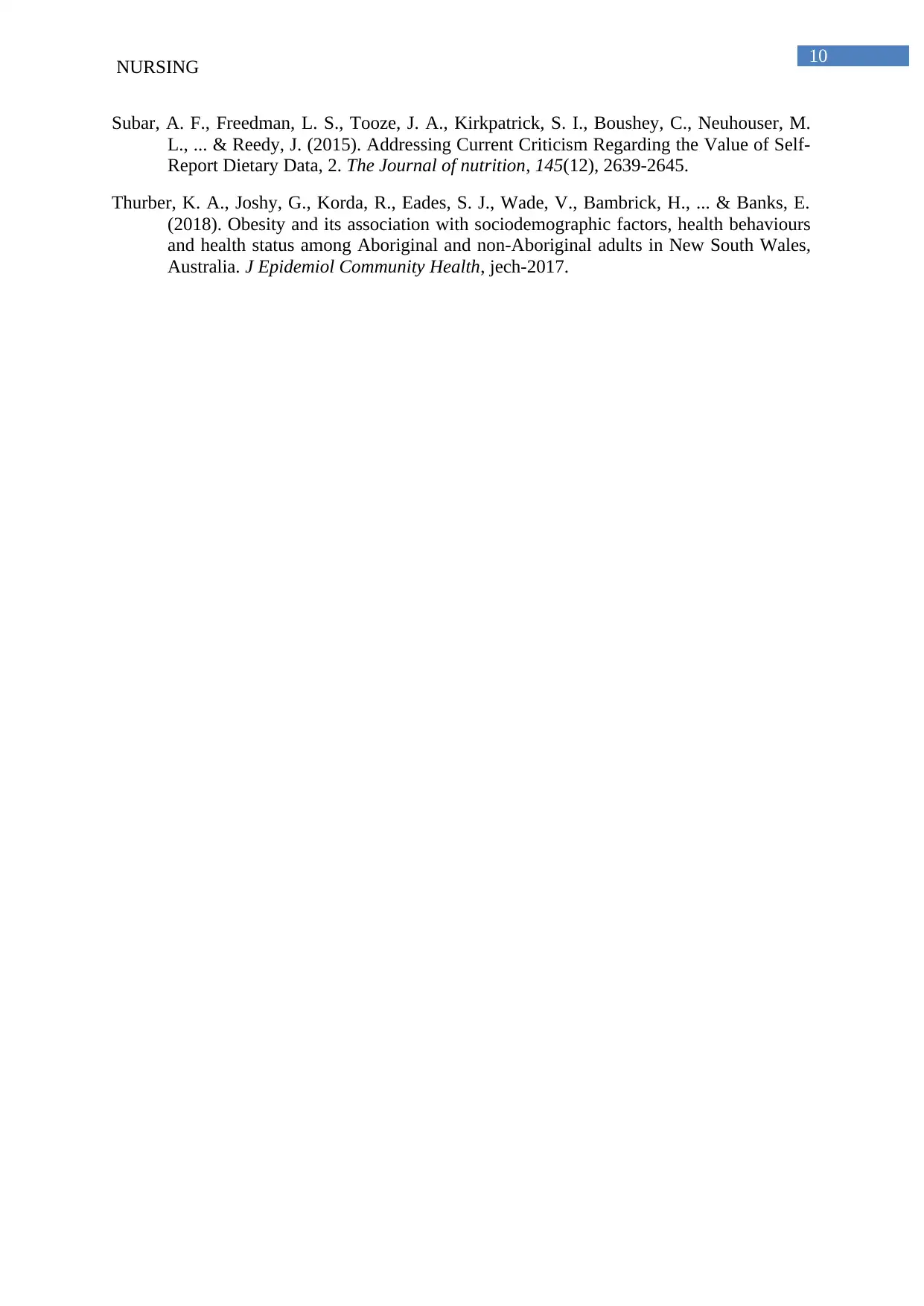
10
NURSING
Subar, A. F., Freedman, L. S., Tooze, J. A., Kirkpatrick, S. I., Boushey, C., Neuhouser, M.
L., ... & Reedy, J. (2015). Addressing Current Criticism Regarding the Value of Self-
Report Dietary Data, 2. The Journal of nutrition, 145(12), 2639-2645.
Thurber, K. A., Joshy, G., Korda, R., Eades, S. J., Wade, V., Bambrick, H., ... & Banks, E.
(2018). Obesity and its association with sociodemographic factors, health behaviours
and health status among Aboriginal and non-Aboriginal adults in New South Wales,
Australia. J Epidemiol Community Health, jech-2017.
NURSING
Subar, A. F., Freedman, L. S., Tooze, J. A., Kirkpatrick, S. I., Boushey, C., Neuhouser, M.
L., ... & Reedy, J. (2015). Addressing Current Criticism Regarding the Value of Self-
Report Dietary Data, 2. The Journal of nutrition, 145(12), 2639-2645.
Thurber, K. A., Joshy, G., Korda, R., Eades, S. J., Wade, V., Bambrick, H., ... & Banks, E.
(2018). Obesity and its association with sociodemographic factors, health behaviours
and health status among Aboriginal and non-Aboriginal adults in New South Wales,
Australia. J Epidemiol Community Health, jech-2017.
1 out of 11
Related Documents
Your All-in-One AI-Powered Toolkit for Academic Success.
+13062052269
info@desklib.com
Available 24*7 on WhatsApp / Email
![[object Object]](/_next/static/media/star-bottom.7253800d.svg)
Unlock your academic potential
© 2024 | Zucol Services PVT LTD | All rights reserved.




